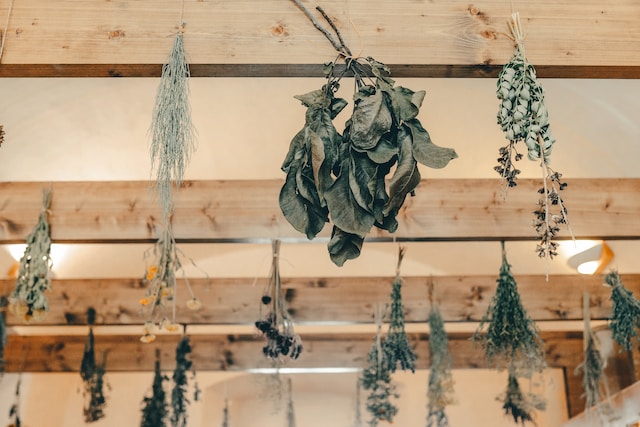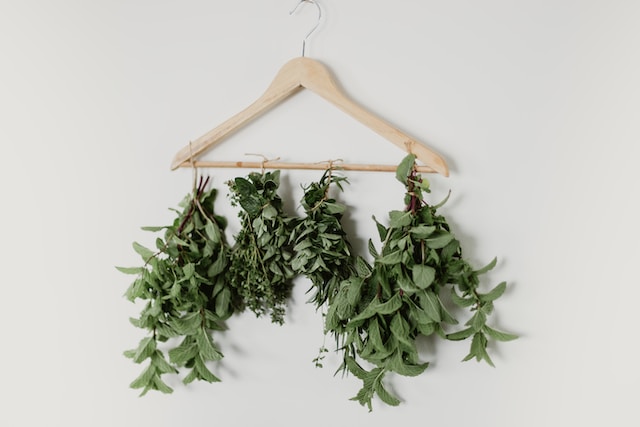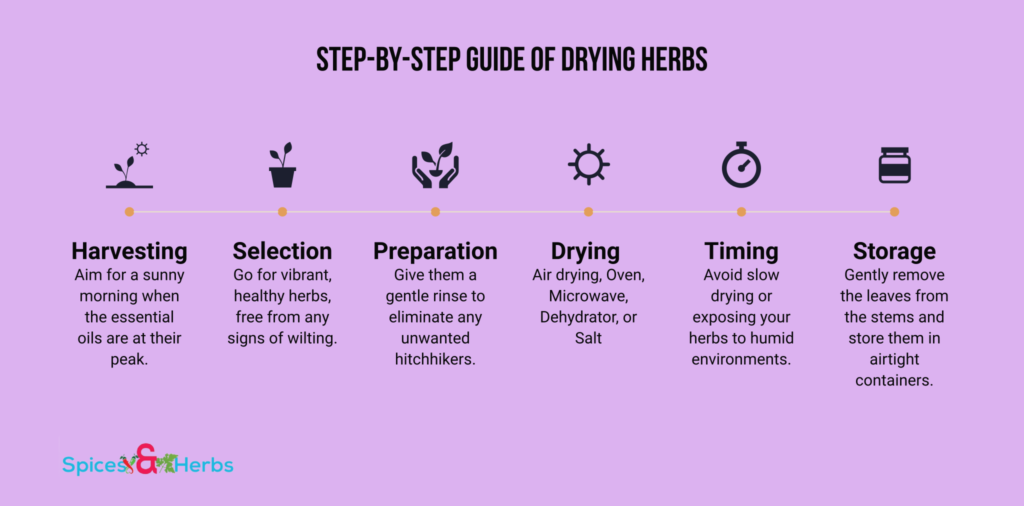Have you ever found yourself reaching for that jar of dried herbs, only to be greeted by a disappointing lack of flavor? It’s a common dilemma faced by many home cooks and culinary enthusiasts. But fear not! In this blog, we will unravel the secrets of preserving the essence of dry herbs, ensuring that they retain their flavors and aroma to elevate your dishes to new heights.
So, let’s bid farewell to lackluster dried herbs and welcome a future filled with vibrant flavors and tantalizing scents. Keep reading to learn more!
How Dry Herbs Enhance Your Culinary Experience

🟦 Extended Shelf Life
Drying herbs is like giving them a magic spell of preservation. Imagine your fresh herbs, bursting with vibrant colors and fragrant aromas, defying the march of time. By drying them, you transform these delicate leaves into long-lasting flavor powerhouses. No more rushing to use up your herbs before they wilt away. With dried herbs, you can savor the taste of summer all year round.
🟦 Intensified Flavor
Drying herbs is like turning up the volume on their flavor profiles. It’s like they’re saying, “Hold on tight, taste buds! We’re about to embark on a flavor adventure!” As the water content evaporates, the essential oils within the herbs become concentrated, resulting in a flavor explosion that’ll leave your dishes begging for more. A sprinkle of dried oregano or a pinch of dried thyme can transform a simple meal into a culinary masterpiece.
🟦 Versatile Culinary Ingredient
Dried herbs are the kitchen superheroes that never fail to save the day. They’re always ready to step up and add a dash of excitement to your cooking endeavors. Need to jazz up a soup? Dried herbs to the rescue! Want to infuse your sauces with aromatic bliss? Dried herbs are here to save the flavor! From marinades to rubs, stews to stir-fries, dried herbs have the power to elevate any dish to new heights of deliciousness.
🟦 Convenience and Accessibility
Picture yourself in the midst of a winter storm, longing for the taste of summer. But fear not, for your secret weapon lies in your pantry—dried herbs! While fresh herbs may be scarce in colder months or when you’re in a pinch, dried herbs come to the rescue, providing a burst of flavor when you need it most. With a well-stocked supply of dried herbs, you can add a touch of culinary magic to any meal, regardless of the season or herb availability.
🟦 Cost-Effective
Let’s face it, buying fresh herbs from the store can sometimes feel like a luxury. But drying herbs puts you in control, allowing you to save both money and flavor. Whether you’ve got a flourishing herb garden or stumble upon a great deal at the local market, drying herbs ensures that none of that precious herb goodness goes to waste. So go ahead, dry those bundles of herbs, and revel in the satisfaction of turning frugality into flavorful abundance.
🟦 Health Benefits
Drying herbs isn’t just about flavor; it’s also about harnessing nature’s healing powers. From soothing chamomile to invigorating peppermint, dried herbs have been used for centuries to support wellness. Infuse them in hot water for a comforting herbal tea, create homemade salves and balms, or sprinkle them onto your favorite dishes for an extra health boost. With dried herbs, you can embrace the harmony of flavor and well-being.
🟦 Decorative and Aesthetic Purposes
Drying herbs isn’t just practical; it’s also visually enchanting. Picture your kitchen adorned with bundles of vibrant, dried herbs hanging from the ceiling or beautifully arranged in glass jars. They add a touch of rustic elegance and earthy charm to your culinary sanctuary. Plus, they serve as a constant reminder of the magic and versatility that lies within those humble leaves.
So, embrace the art of drying herbs and unlock a world of flavor, convenience, and culinary delight. With each sprinkle and pinch, you’ll be adding a touch of dried herb enchantment to your culinary creations.
Most Effective Methods to Dry Herbs with Flawless Precision
There are several common methods for drying herbs. Here are a few popular ones:
🟩 Air Drying
This method involves hanging the herbs upside down in a warm, dry location with good airflow. Bundle a few stems together and tie them with a string or rubber band. Hang them upside down in a well-ventilated area away from direct sunlight. It typically takes 1 to 2 weeks for the herbs to fully dry using this method.
🟩 Oven Drying
Oven drying is a quicker method that requires low heat. Spread the herbs in a single layer on a baking sheet lined with parchment paper. Place the herbs in an oven set to the lowest temperature, usually between 90-120°F (32-49°C). Keep the oven door slightly ajar to allow moisture to escape. Check on the herbs regularly, as they can dry faster in the oven compared to other methods.
🟩 Microwave Drying
This method is the fastest but requires careful monitoring. Place the herbs on a microwave-safe plate lined with a paper towel. Microwave them in short intervals of 20-30 seconds on low power until they are dry and crispy. Be cautious not to burn the herbs, as they can quickly overheat.
🟩 Food Dehydrator
Using a food dehydrator is a convenient and efficient method for drying herbs. Follow the manufacturer’s instructions for drying herbs, as different models may have specific settings. Typically, you’ll place the herbs on the dehydrator trays and let the machine do the work. The drying time will depend on the herb and the dehydrator’s settings.
🟩 Herb Infused Salt
Another unique way to dry herbs is by making herb-infused salt. Finely chop or grind the dried herbs of your choice and mix them with coarse sea salt. Spread the mixture on a baking sheet and let it air dry or use the oven on low heat to remove any moisture. Once the herb-infused salt is dry, store it in an airtight container. This method allows you to preserve the herbs’ flavor while creating a versatile seasoning.
Choosing the Best Drying Method for Herbs

Ah, the age-old conundrum: how to choose the perfect drying method for your precious herbs? Fear not, my herb-loving friend, for I shall guide you through this aromatic adventure! Each drying method holds its own unique charm, so let’s explore the factors that will help you make the best decision:
🟨 Herb type
Imagine a grand gathering of herbs, each with its own personality and drying preferences. Some herbs like rosemary, thyme, and sage boast sturdy leaves as if they were nature’s warriors. These resilient herbs fare splendidly with the gentle art of air drying, as they gracefully release moisture over time. Delicate herbs like parsley or mint, on the other hand, require a speedier approach to retain their vibrant flavors.
🟨 Time
If you have the luxury of patience, air drying is a delightful dance with tradition. Embrace the slow rhythm, allowing your herbs to gracefully shed their moisture and preserve their flavors. But, if the clock tick-tocks against you, and your desire for dried herbs grows stronger by the minute, fear not! An oven or dehydrator shall come to your rescue, whisking away moisture with a touch of magic.
🟨 Equipment availability
Just as a chef needs their trusty utensils, drying herbs requires the proper tools. For the charming path of air drying, a humble string or trusty rubber bands shall suffice, along with a well-ventilated area. But if an oven or dehydrator graces your kitchen, consider their abilities to expedite the drying process. Choose the method that aligns with your equipment collection and dance with the tools you possess.
🟨 Space and weather conditions
Picture your herbs, basking in the gentle breeze, embracing the sun’s warm caress. Air drying requires a spacious sanctuary, a place where herb bundles can hang freely and sway in the wind. Seek a well-ventilated area away from direct sunlight, for even herbs desire a gentle touch. However, if your surroundings are shrouded in humidity, fret not! The oven or dehydrator shall provide a reliable refuge, shielding your herbs from spoilage and bestowing upon them the gift of speedy drying.
🟨 Desired end result
With air drying, herbs retain their natural shape, a picturesque celebration of their botanical beauty. Each herb possesses its unique color and texture, allowing you to revel in nature’s artistry. But if uniformity beckons you if you desire a more consistent appearance, an oven or dehydrator can weave their magic. These methods offer herbs that are uniformly dried, giving your spice rack a touch of culinary elegance.
🟨 Flavor preservation
Let us not forget the ultimate quest: to preserve the flavors that nature has bestowed upon our cherished herbs. The art of drying presents challenges, but fear not, for flavor shall prevail! Air drying, with its slow and gentle approach, has the potential to preserve more of those precious essential oils. The dance of time allows flavors to concentrate, ensuring a burst of herbaceous delight in every dish. However, the oven and dehydrator, when approached with care, can also retain flavors through low-temperature drying, a delicate balance between heat and preservation.
Common Mistakes You Must Avoid When You Dry Herbs
When drying herbs, there are a few common mistakes that you should avoid to ensure the best quality and flavor of your herbs. Here are some mistakes to steer clear of:
🟥 Waiting too long to harvest
Picture this: a sunny morning, birds chirping, and your herb garden flourishing. It’s time to pluck those vibrant leaves at their peak flavor and aroma. Waiting too long means missing out on the herb harvest hoopla! So, keep an eye on your herbs, and when they’re at their flavorful best, grab your gardening shears and embark on a herb-harvesting adventure.
🟥 Not washing the herbs
Before you send your herbs to the drying zone, give them a refreshing spa treatment. Gentle washing with cool water will help remove any dirt, dust, or unwelcome guests. Pamper your green beauties with a soothing rinse, and then let them relax and air dry.
🟥 Using high heat
Keep your herbs away from the culinary inferno! High heat sources like ovens or microwaves might seem like quick-drying options, but they can lead to an unfortunate flavor meltdown. Opt for low-heat methods like air drying or a dehydrator set to a low temperature. Your herbs will retain their cool and their full flavor profile.
Now that you know what to avoid, it’s time to do the correct process! Check the next section.
How to Dry Herbs Without Losing Their Flavor
So, you’ve got a bountiful herb garden, and you want to preserve those incredible flavors for a rainy day? Drying herbs is your answer! Not only does it give you the opportunity to enjoy your herbs all year round, but it also adds a rustic charm to your kitchen. But hold on, we don’t want those precious flavors to evaporate along with the moisture, right? Here’s how you can dry herbs without losing their incredible taste:

Step 1: Harvesting
Picture a picturesque morning, the sun gently kissing your garden, and the fresh scent of herbs in the air. That’s the ideal time to harvest your herbs! Aim for a sunny morning when the essential oils are at their peak, giving your herbs maximum flavor.
Step 2: Selecting herbs
Now, choose your herb buddies wisely. Go for vibrant, healthy herbs, free from any signs of wilting or disease. Rosemary, thyme, oregano, sage, mint, and parsley are all fantastic candidates for drying. They’ll bring a burst of flavor to your culinary adventures.
Step 4: Preparing the herbs
Before diving into the drying process, show your herbs a little TLC. Give them a gentle rinse to eliminate any unwanted hitchhikers like dirt or insects. Pat them dry with a paper towel, ensuring not to bruise or harm those delicate leaves.
Step 5: Choose the drying method
For this step, you can refer to the list of drying methods listed above.
Step 6: Timing
Ah, the delicate balance of timing! To retain those incredible flavors, aim for a speedy drying process. We want to preserve the essential oils and prevent them from evaporating into thin air. Avoid slow drying or exposing your herbs to humid environments, as that can lead to flavor loss. Keep things swift and ensure your herbs are as potent and tasty as ever!
Step 7: Storage
Congratulations! You’ve successfully transformed your vibrant herbs into flavorful, dried delights. Now, let’s give them a cozy home. Gently remove the leaves from the stems and store them in airtight containers, like adorable herb sanctuaries. Don’t forget to label each container with the herb’s name and the date of drying, as even the most seasoned chefs need reminders. Keep these flavor treasures in a cool, dark place, away from sunlight’s prying eyes. They’ll be ready to sprinkle their magic into your dishes whenever you need them.
With these steps, you’re well on your way to becoming a herb-drying maestro! Get creative, experiment with different herbs, and embrace the joy of preserving nature’s flavors.
Proper Storage After Your Dry Herbs Without Losing Their Flavor
Proper storage of herbs is essential to maintain their flavor and potency. Here are some tips to help you store your dried herbs effectively:
🟫 Choose the right containers
Think of your herbs’ storage containers as their cozy little homes. Opt for airtight glass jars or containers with snug lids. Plastic containers, on the other hand, can be like clingy neighbors who absorb the flavors and aromas of your herbs, resulting in a less vibrant taste.
🟫 Keep away from heat and light
Imagine your herbs as delicate creatures who prefer a cool and shady environment. Protect them from direct sunlight and the scorching heat that could diminish their quality. Find them a peaceful spot, like a quiet pantry or cupboard, where they can relax undisturbed.
🟫 Avoid moisture
Moisture is the enemy of freshness and flavor, so keep your herbs as dry as possible. Give them a thorough drying session before storing them, and make sure to avoid storing them in humid areas, like right next to the stove or sink. It’s like sending them on a well-deserved vacation to a dry and serene place.
🟫 Label and date
Treat your herbs with the respect they deserve by providing them with proper identification. Label each container with the herb’s name and the date of storage. This way, you’ll avoid any mix-ups and be able to keep track of their freshness, ensuring they don’t feel lost or neglected.
🟫 Use whole leaves
Picture your herbs as majestic kings and queens, with their leaves standing tall and proud. To preserve their regal flavor, store them in their whole leaf form rather than grinding them into a powder. Whole leaves have a longer-lasting zest and give you the opportunity to marvel at their beauty.
🟫 Don’t crush until use
Just like unlocking a treasure chest, crushing or grinding herbs releases their aromatic and flavorful secrets. To keep them fresh and vibrant for longer, resist the temptation to crush them until you’re ready to use them. It’s like saving the grand unveiling for the perfect moment.
🟫 Store in small quantities
Remember the phrase “quality over quantity”? The same applies to herb storage. It’s better to store herbs in smaller quantities, creating a cozy retreat for each one, rather than cramming them all together. This minimizes their exposure to air and moisture, ensuring they maintain their distinct personalities.
🟫 Avoid frequent opening
Each time you open the container, you’re essentially inviting air and moisture to crash your herb party. Keep the interruptions to a minimum by swiftly taking out what you need and promptly sealing the container shut. Think of it as preserving their privacy and protecting their essence.
🟫 Consider freezing or refrigeration
If you live in a particularly challenging climate with the scorching heat or high humidity, your herbs might appreciate a cool vacation in the refrigerator or freezer. However, be aware that this may slightly alter their flavor and texture, like a change of scenery that comes with its own unique charm.
By following these whimsical storage guidelines, you’ll create a delightful haven for your herbs, ensuring they retain their captivating flavors and aromas.
Final Words
In conclusion, preserving the flavors of dry herbs is an essential aspect of culinary mastery. By employing a few simple techniques, you can ensure that your herbs retain their aromatic essence, enhancing the taste of your dishes and elevating your cooking to new heights.
Unlock the full potential of your dried herbs, infusing your dishes with their distinctive and delightful tastes. So go ahead, experiment, and savor the magic of herbs that will elevate your culinary experiences and nourish your well-being. Happy cooking!
